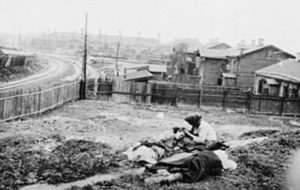UKRAINE: HOLODOMOR, Stalin’s artificial famine in Ukraine 90 years ago today (1)
Millions of Ukrainians died
By Dr Ievgeniia Gidulianova for Human Rights Without Frontiers

HRWF (25.11.2023) – In Ukraine, it is not customary to throw away bread. Never.
“Bread is the head of everything” is one of the main Ukrainian proverbs.
And this is not only in gratitude to the fertile plant, which is supposedly born to give the best harvests. This is also a tribute to the difficult times that Ukraine was forced to go through.
This testament is passed down from generation to generation, because the grief through which Ukrainians have been preserved in them almost at the genetic level. The memory of the famine was preserved in the families of those who were able to survive it.
This year, on November 25, Ukraine celebrates Holodomor Remembrance Day. It is a day to commemorate those dark times and the 90th anniversary of our mourning for all the innocent victims of those times.
Available data on the number of victims of the Holodomor give us figures of at least 4.6 million dead. Some researchers point to much higher figures – up to 10.5 million.
This is another sorrowful page of Ukrainian history, when millions of human lives were lost for their struggle on the way to independence and self-reliance.
After the overthrow of the Ukrainian People’s Republic in November 1920, the Bolshevik regime began active actions on its territory to prevent the restoration of an independent Ukrainian state through a brutal repressive policy aimed at establishing a communist system and suppressing any parties and movements that defended the idea of Ukrainian independence.
Stalin Y.V., Molotov V.V., Kaganovich L.M., Postyshev P.P., Kosior S.V., Chubar V.Y. and Khatayevich M.M. used the repressive apparatus of the communist totalitarian regime on the territory of Ukraine in peacetime. A complete forced collectivization of agriculture and the deportation of Ukrainian peasant families, illegal confiscation of their property, repression and physical destruction of Ukrainians were initiated.
All this destroyed the traditional forms of agricultural production and deprived the Ukrainian peasants of the grain reserves necessary for normal life, which caused famine among the Ukrainian population in 1928-1929, after which mass anti-Soviet uprisings began on the territory of the Ukrainian SSR, which were suppressed with particular cruelty by punitive measures.
In order to suppress the resistance of the Ukrainian people in 1932-1933 in Ukraine, the communist totalitarian regime of the USSR planned and implemented the crime of exterminating millions of Ukrainians by creating an artificial famine. To denote this tragedy, Ukrainians use the word “Holodomor”, which comes from the Ukrainian words “famine” and “pestilence”. It was the premeditated murder of millions of Ukrainians in order to destroy the social foundations of the Ukrainian people, its age-old traditions, spiritual culture and ethnic identity.
The regime managed to hide its crime behind a wall of propaganda and lies within the USSR and abroad.

“Dead of starvation and people dying near the fence of the Ozeryanskaya Church in Kharkiv.”
Photo from 1933 by Austrian chemical engineer Alexander Wienerberger.
In 1932-33 there was neither a significant drought nor other weather conditions that could lead to crop failure and eventually to mass starvation. Historian Viktor Brekhunenko wrote in his book “ Myths about the Holodomor” that the harvest of 1932 was smaller than the harvest of 1931 (12.8 million tons versus 17.7 million tons). The reason for the decrease in the harvest was the state policy on collectivization but even such a harvest was enough to feed people.
However, famine occurred in Ukraine and in those regions of the USSR where Ukrainians constituted the majority of the population: the Kuban (more than 50% of the population was Ukrainians, according to the 1926 census), some regions of the North Caucasus and the Middle and Lower Volga regions. During these times, there was no famine or crop failure in Ukraine’s neighboring territories, such as Poland and Belarus. But it was impossible for Ukrainians dying of hunger to get there, as the USSR closed the borders to Ukrainian peasants.

Victims of famine. Kharkiv region, 1933. Photo courtesy of Alexander Wienerberge
As a first step, the Communist leaders planned unrealistic grain procurement figures, as they planned to take 53% from the 1932 harvest, although in 1931 this figure was 39%. And this was in conditions when it was quite clear that such actions would cause hunger.
The unrealistic grain procurement plan of 1932 was not fulfilled. Consequently, on 1 December 1932, it was decided to seize grain and other products from the peasants. Later, in January 1933, in order to implement the plan, the Kyiv Regional Committee of the Communist Party of Ukraine demanded “all available grain, including the so-called seed funds,” that is, the grain that should be sown in the spring.
Peasants stopped paying “workdays”, a payment in kind in the form of farm products for work on the collective farm. As a result, all the food was taken away from the peasants. At the same time, Stalin considered the impossibility of reaching the grain norm to be a “war against Soviet power” and the peasants were persecuted as enemies of the state.
From January-February 1932, grain began to be taken away in Ukraine and, accordingly, entire villages began to starve.*
On 15 January 1932, the Politburo of the Central Committee of the Communist Party of Ukraine adopted a resolution titled “The Question of Grain Procurement”, according to which control over the activities of the regional leadership during the seizure of grain was strengthened.
Methods of grain requisition became more and more cruel. Collective farms, which were thus left without grain, were officially denied seed assistance. At the same time, a method of repression called “Black Boards” was actively used. Some villages (collective farms) for non-fulfillment of plans for the transfer of grain to the state ended up on the “black board” (they were published in newspapers and documents).
At that time, they stopped importing food and goods and the existing goods were exported. The exits from the villages were guarded by domestic troops, not letting the inhabitants out and hereby condemning them to starvation. At the same time, the search for enemies of the authorities continued. The repression was harsh. People were expelled from their homes, all their property was taken away and they were sent into exile or shot.
Analysis of 20,000 cases, conducted by N.A. Ivnitsky in his work “The Repressive Policy of the Soviet Government in the Countryside (1928-1933) (The University of Toronto (Canada) shows that 83 percent of the prisoners were people from collective farms and individual peasants, and only 15 percent were “kulak-wealthy elements.”
Places of mass starvation were guarded by military border guards. It was impossible to buy railway tickets and people were not allowed into the cities.
On 29 March 1932, the decree “On Polissya” increased repression of peasants in the Ukrainian SSR. A first group of 5000 families from the districts of Polissya were deported to especially created settlements for the development of stone and clay quarries. In addition, the deportation of another 5,000 families from Ukraine was also decided and implemented.
On 7 August 1932, Stalin and Kaganovich organized the adoption by the Central Executive Committee (CEC) and the Council of People’s Commissars of the USSR of the resolution “On the Protection of the Property of State Enterprises, Collective Farms, and Cooperatives and the Strengthening of Public (Socialist) Property,” which introduced executions, confiscation of property, and prohibited the use of amnesty.
This law was popularly called the “Law of Five Ears of Grain“. It even covered cases when starving peasants tried to collect grains in the field that were accidentally left after harvesting. Even children were punished. As early as 14 September, the People’s Commissariat of Justice of the Ukrainian SSR testified about 250 death sentences in a memorandum.
On 25 October, the Plenum of the Central Committee of the CP(b)U adopted the Resolution of the Politburo of the Central Committee of the CP(b)U “On the Need to Overcome the Country’s Lag in the Fulfillment of the Grain Requisition Plan.”
It ordered the party organizations to achieve an immediate change in grain procurements and operational management of grain procurements, to organize a “struggle for bread”, to make November and the last days of October decisive for the implementation of the grain requisition plan, to implement the annual plan ten times faster by the 15th anniversary of the October Revolution.
It advised “ruthlessly suppressing all attempts of the class enemy and its agents aimed at disrupting grain procurements.” As early as November 1932, the Molotov Commission introduced a system of special brigades for grain requisition.
The tragedy of the Holodomor of 1932-1933 in Ukraine was officially denied by the Soviet authorities for many decades, and those who raised this issue were severely punished.
(*) At the same time, it should be noted that while Ukrainian peasants were starving, as of May 1933, 2.7 million tons of grain from the 1932 harvest had been exported through seaports. As a result, Ukraine fulfilled the plan for the supply of grain for export by 97%.
